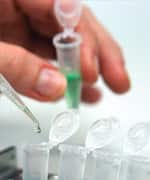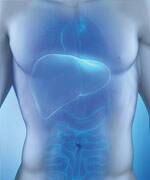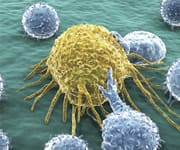Life Extension Magazine®
New Study Finds Calorie Restriction Slows Aging | |
Yet another study confirms what Life Extension® has long asserted—calorie restriction can help slow down the aging process and prevent chronic disease. The current study, performed by scientists at the NYU Langone Medical Center, has found that cutting calories—especially carbohydrates—by 30% could beneficially halt the activity of nearly 900 different genes related to aging and memory formation in the brain.* Lead researcher Stephen D. Ginsberg, PhD, and colleagues fed food pellets containing fewer calories to female mice than those fed to other mice. They then analyzed tissue from the hippocampal region of the brain, an area that is affected earliest in Alzheimer’s disease. “Our study shows how calorie restriction practically arrests gene expression levels involved in the aging phenotype; how some genes determine the behavior of mice, people, and other mammals as they get old,” said Dr. Ginsberg. Editor’s Note: While Ginsberg cautions that the study doesn’t call calorie restriction a “fountain of youth,” he does remark that it “adds evidence for the role of diet in delaying the effects of aging and age-related disease.” |
|
| Reference | |
* Presented at the Society for Neuroscience annual meeting in Washington, D.C., Nov. 17, 2014. |
|
Colchicine Treats Acute Pericarditis | |
According to a randomized trial published in the New England Journal of Medicine, patients with recurring pericarditis (swelling of the pericardium, the thin membrane surrounding the heart) who are treated with colchicine, a common gout medication, in combination with conventional anti-inflammatory therapy, experienced a significantly reduced rate of incessant or recurrent pericarditis.* In the study, half the patients were randomly assigned to receive three months of traditional anti-inflammatory therapy plus either colchicine (0.5 mg once or twice daily depending upon weight) or placebo. Most study participants were also given aspirin, while a small percentage received ibuprofen. Massimo Imazio, MD, of Maria Vittoria Hospital in Turin, Italy, and colleagues followed the patients for an average of 22 months. They found that 16.7% of patients given colchicine were diagnosed with incessant or recurrent pericarditis, while 37.5% of patients in the control group were diagnosed. This study showed that this old line gout drug (colchicine) can cut the incessant or recurrence rate of pericarditis by around 50%. Editor’s Note: The study confirms current European guidelines, which give a class IIa indication for the use of colchicine in acute pericarditis. |
|
| Reference | |
* N Engl J Medicine. 2013, Sep 1. |
Scientists Replicate Human Brain Cells In Petri Dish |
Researchers have successfully grown neurons in a lab that duplicate the course of Alzheimer’s disease. This will enable the rapid testing of many new drugs that could lead to an Alzheimer’s cure. The current mouse model of Alzheimer’s has several limitations that impede research initiatives. In the journal Nature, lead researcher Rudolph Tanzi of Massachusetts General Hospital in Boston said the key to success happened after colleague Doo Yeon Kim suggested growing human brain cells in a gel, which allowed them to form networks similar to an actual brain.* Within weeks, cells developed hard clumps known as plaques and coils known as tangles—both features of Alzheimer’s that disrupt normal brain activity. This new technique, say researchers, makes testing Alzheimer’s drugs faster, cheaper, and more relevant and can be used to test drugs within a few months, rather than the year it takes to test on mice. Editor’s Note: Dr. Tanzi is beginning an ambitious project to test 1,200 drugs on the market and 5,000 experimental ones that have finished the first phase of clinical testing—a project that is impossible with mice, for which each drug test takes a year. With their petri dish system, Dr. Tanzi said, “we can test hundreds of thousands of drugs in a matter of months.” |
|
| Reference | |
* Nature. 2014, Oct 12. |
|
Multinutrient Plus Calcium Associated With Lower Colon Cancer Risk | |
The results of a meta-analysis published online on October 21, 2014, in the International Journal of Cancer add to the evidence that dietary supplementation provides protection against the risk of colorectal cancer.* “To the best of our knowledge, no systematic review and meta-analyses of prospective cohort studies have been conducted that focus on colorectal cancer risk and use of dietary supplements specifically,” write authors Renate C. Heine-Bröring and colleagues in their introduction to the article. Dr. Heine-Bröring and associates selected 24 studies that examined the association between supplement use and colon cancer for their analysis. Compared to no use, the use of multivitamin supplements was associated with a 7% lower risk of colorectal cancer. For users of calcium supplements, a 14% lower risk of the disease was uncovered. Editor’s Note: The authors recommend further substantiation of the findings by randomized controlled trials involving large populations and long follow-up periods. | |
| Reference | |
* Int J Cancer. 2014 Oct 21. | |
CoQ10 Can Reduce Symptoms Of Gulf War Illness | |
|
Veterans who fought to free Kuwait from an Iraqi invasion in 1990 to 1991 may find relief from their symptoms following supplementation with CoQ10, according to a study published in Neural Computation.* The chronic health problems dubbed Gulf War Illness include fatigue, headaches, muscle pain and weakness, skin issues, and decreased cognitive function. Researchers at the University of California, San Diego School of Medicine, recruited 46 Gulf War veterans for a randomized, double-blind, placebo-controlled study. For 3.5 months, the participants received either 100 mg CoQ10 or placebo daily. General health and illness-related symptoms were rated before and after treatment. Among participants who received 100 mg CoQ10, 80% experienced improvement in physical function that was associated with increasing blood levels of the coenzyme. Headache, fatigue with exertion, irritability, memory, and muscle pain also improved among those who received CoQ10. The researchers plan to test a “mitochondrial cocktail” containing CoQ10 and other nutrients in a future study. Editor’s Note: “Gulf War Illness is not the same as post-traumatic stress disorder or traumatic brain injury, signature illnesses of later deployments, which are caused by psychological and mechanical injury, respectively,” said study leader Dr. Beatrice Golomb. “Evidence instead links Gulf War Illness to chemical exposures, such as pesticides or pills given to soldiers to protect them from possible nerve agents. These chemicals can damage mitochondria, which generate the energy our cells need to do their jobs. When these powerhouses of the cells are disrupted, it can produce symptoms compatible with those seen in Gulf War Illness.” | |
| Reference | |
* Neural Comput. 2014 Nov;26(11):2594-651. | |
Arthritis Drugs May Increase Stroke Risk Mortality | |
The journal Neurology® published a study that found commonly prescribed arthritis medications may increase one’s risk of dying from a stroke. The drugs evaluated by researchers were COX-2 inhibitors, which include celecoxib, rofecoxib, diclofenac, meloxicam, and etodolac, among others.* Researchers at Aarhus University Hospital in Aarhus, Denmark, analyzed the medical records of over 100,000 people hospitalized for a first stroke between 2004 and 2012. The results showed that of those currently using a COX-2 inhibitor, 19% were more likely to die after a stroke than those who didn’t take the drug and new users of the medicines had a 42% increase in risk mortality from stroke compared to non-users. Those taking a specific COX-2 called etodolac were 53% more likely to die from stroke compared to non-users. “While newer versions of COX-2 drugs have been pulled from shelves, older ones are still frequently prescribed,” said study author Dr. Morten Schmidt. “Our study provides further evidence solidifying the risks of certain arthritic pain relievers and death from stroke.” Editor’s Note: “We found 30-day mortality from stroke increased by around 20% if patients were taking a COX-2 inhibitor before admission,” said study co-author Christian Christiansen, PhD, of Aarhus University Hospital. “No such effect was seen with regular NSAIDs [nonsteroidal anti-inflammatory drugs].” | |
| Reference | |
* Neurology. ® 2014 Nov 5. | |
Soap Ingredient Linked To Liver Disease | |
A new study published in Proceedings of the National Academy of Sciences found that regular exposure to triclosan, an antimicrobial ingredient in antibacterial hand soaps, can cause liver cancer in laboratory mice.* Researchers from the University of California, San Diego School of Medicine, say the chemical disrupted liver integrity and compromised liver function in mice models that were given a procarcinogen to promote liver cancer. Mice exposed to triclosan for six months (equivalent to approximately 18 human years) formed more tumors than the control group, and the tumors proved to be larger and more frequent than in mice not exposed to triclosan. The researchers say triclosan may cause liver cells to multiply and turn fibrotic. In the long run, continued liver fibrosis encourages tumor formation. “Triclosan’s increasing detection in environmental samples and its increasingly broad use in consumer products may overcome its moderate benefit and present a very real risk of liver toxicity for people, as it does in mice, particularly when combined with other compounds with similar action,” said study leader Dr. Robert Tukey. Editor’s Note: According to Dr. Colleen Rogers, a lead microbiologist at the Food and Drug Administration, washing with antibacterial soaps doesn’t prevent illness any better than regular soaps. “New data suggest that the risks associated with long-term, daily use of antibacterial soaps may outweigh the benefits,” she said. | |
| Reference | |
* Proc Natl Acad Sci. 2014 Nov 16. | |
Supplementing With CoQ10 Reduces Statin-Related Muscle Pain | |
A double-blinded trial reported in Medical Science Monitor found a reduction in mild-to-moderate muscle pain related to the use of statin drugs.* In the randomized study, 50 middle-aged statin users who reported muscle ache and pain for at least six months received 50 mg CoQ10 or placebo twice daily for 30 days. Before and after treatment, researchers from the University of Ljubljana Medical Center in Slovenia provided questionnaires concerning pain severity and how often it interfered with daily activities. Blood samples were analyzed for lipid, liver enzyme, and muscle enzyme levels at the start of the study and 30 days afterward. By the end of the study, muscle pain intensity had decreased by 33% and pain interference by 40% among those who received CoQ10. It remained unchanged in the placebo group. Seventy-five percent of the CoQ10 group experienced a decrease in statin-related muscle symptoms, with no change in lipids, liver enzymes, or muscle enzymes. Editor’s Note: Myalgia is the most common adverse effect associated with the use of statins, which renders those who are intolerant of the symptoms unable to avail themselves of the drugs’ potential benefits. | |
| Reference | |
* Med Sci Monit. 2014 Nov 6;20:2183-8. | |
Common Compound Found In Fruit May Promote Weight Loss | |
A compound similar to resveratrol can reduce fat accumulation and battle obesity, according to new research published in the Journal of Agriculture and Food Chemistry.* The study, conducted by lead researcher Saioa Gomez-Zorita of the University of the Basque Country in Spain, tested the effects of pterostilbene—a phenolic compound found in a variety of foods and beverages, including blueberries and red wine—on six-week-old rats that were fed a high-fat, high-sucrose diet. One-third of the animals were given a low dose of pterostilbene (15 mg/kg body weight), while another third were given a high dose (30 mg/kg body weight), and the remaining rats served as controls. After six weeks, the rats fed a low dose of pterostilbene reduced adipose tissue mass by an average of 15.1%, while the high-dose animals lost 22% adipose tissue mass. Editor’s Note: Tissue fatty acid synthase was reduced in both groups that received pterostilbene, and AMPK, an enzyme involved in cellular energy regulation, was increased in the group that received the higher dose. In the liver, pterostilbene was associated with an increase in enzymes associated with fatty acid oxidation. | |
| Reference | |
* J Agric Food Chem. 2014 Aug 20;62(33):8371-8. |
|
Selenium Reduces Chemo Side Effects In Pediatric Cancer Patients | |
The results of a crossover trial reported in the Journal of Medicinal Food revealed that supplementing with selenium can reduce chemotherapy side effects, including nausea and fatigue.* Researchers randomized 39 children and adolescents to receive a placebo or an age-appropriate daily dose of selenium, ranging from 27 to 100 micrograms of selenium. Both groups underwent a washout phase at the end of the 30-day treatment period, followed by another 30 days in which the treatment protocol was reversed. In addition, eight patients from each group were followed for one year during which they received the age-appropriate dose of selenium. Patients with solid tumors who supplemented with selenium reported significantly less fatigue and nausea during the follow-up phase. Participants with leukemia and lymphoma experienced an improvement in physical function, which was evident after the first 30 days of supplementation as well as at the end of one year among those in the follow-up group. Editor’s Note: Kidney and liver function were also improved in the supplemented subjects in comparison with those who received a placebo. | |
| Reference | |
|
* J Med Food. 2014 Nov 7. | |
Drinking Sugar-Sweetened Soda Makes Cells Age Faster | |
|
An article published in the American Journal of Public Health revealed an association between drinking sugar-sweetened sodas and shorter telomeres—the caps at the ends of chromosomes that naturally shorten with each cell cycle.* The study included 5,309 participants between 20 and 65 years of age enrolled in the 1999-2002 National Health and Nutrition Examination Survey (NHANES). Twenty-four hour dietary questionnaire responses were analyzed for sugar-sweetened soda, diet soda, noncarbonated sugar-sweetened beverages, and fruit juice intake. White blood cell telomere length was measured in the University of California, San Francisco, laboratory of study co-author and Nobel Prize winner Elizabeth Blackburn, PhD. After adjustment for several factors, increased sugar-sweetened soda intake was associated with a reduction in telomere length. No association was found between diet sodas or noncarbonated sugar-sweetened beverages and telomere length. Editor’s Note: Increased telomere shortening has been associated with oxidative damage, inflammation, and chronic diseases, including diabetes. | |
| Reference | |
* Am J Pub Health. 2014 Oct 16. |










